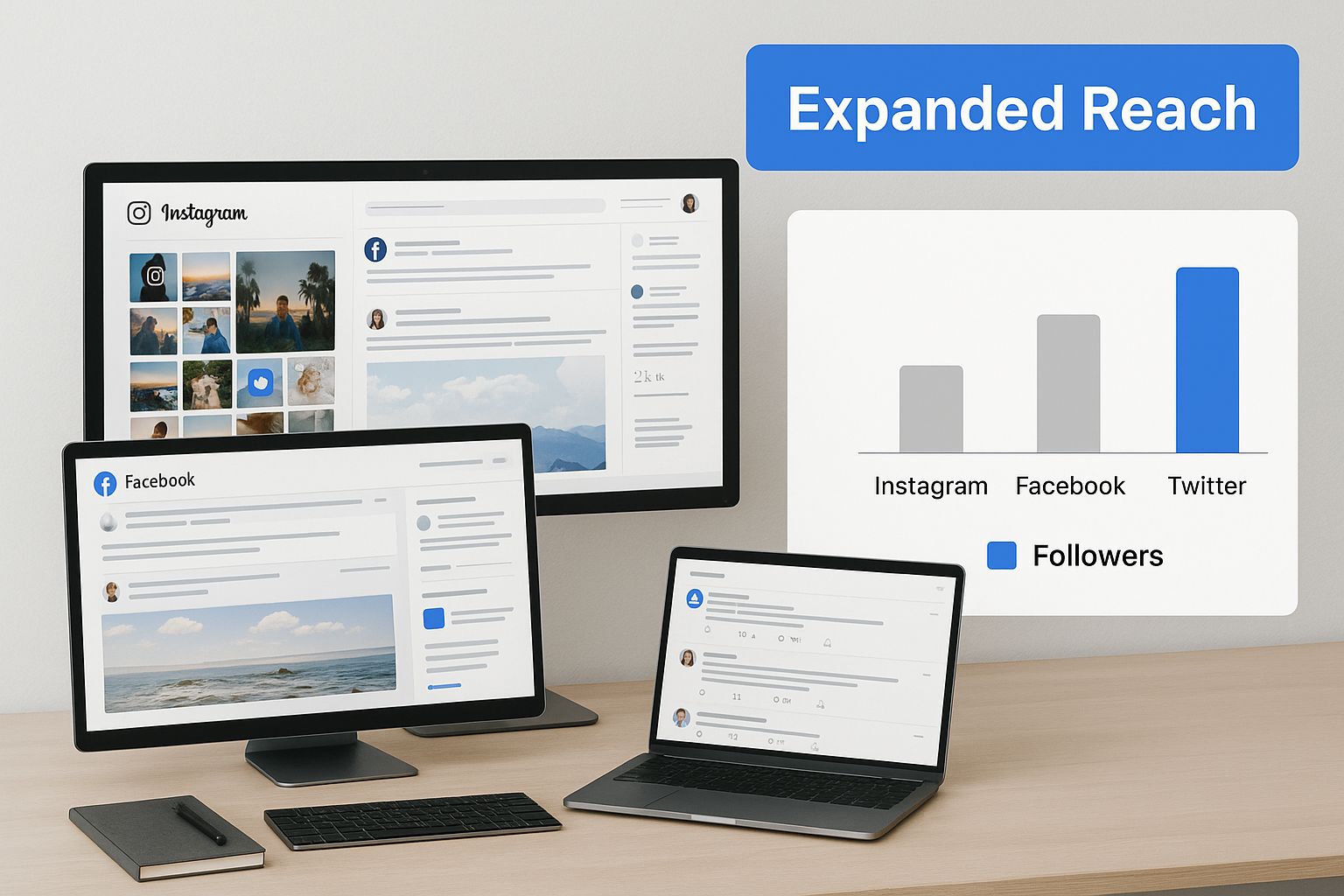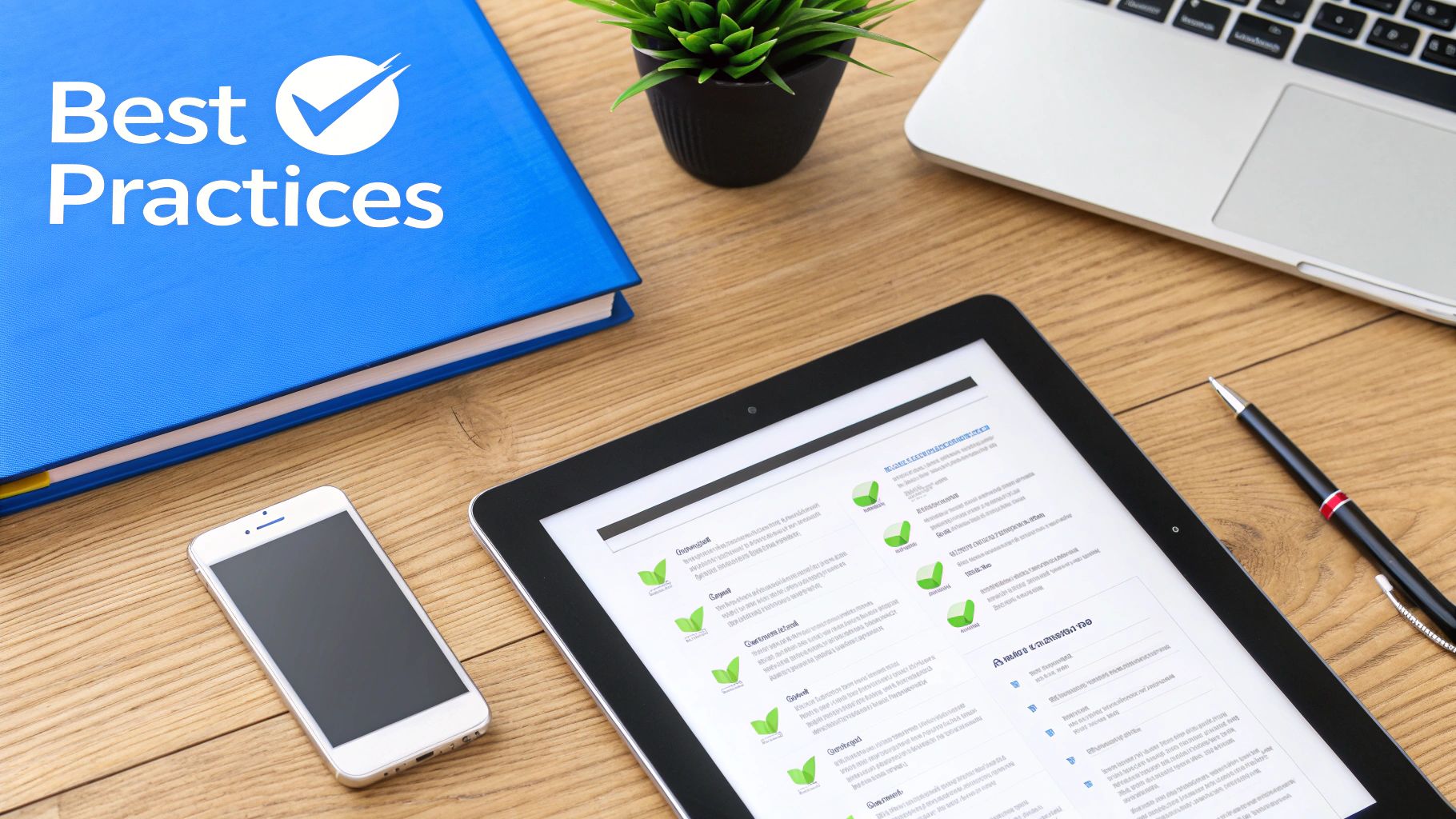Why Cross-Platform Posting Is Your Secret Weapon
Managing multiple social media accounts can feel like a juggling act. Constantly switching between platforms, adapting posts, and monitoring engagement across each channel takes significant time and energy. Cross-platform posting offers a solution, enabling you to distribute content efficiently across all your social media channels at once. This streamlined approach can significantly improve your content distribution strategy, offering advantages for individuals, small businesses, and large corporations.
Reclaim Your Time and Boost Efficiency
One of the most immediate benefits of cross-posting is the time saved. Rather than spending hours each week individually crafting and scheduling posts for each platform, you can consolidate this process into a single workflow. For instance, if you manage five platforms and spend 15 minutes per platform, per post, that's 75 minutes per post. Cross-posting dramatically reduces this time, freeing up hours each week for other essential tasks like creating content and engaging with your audience.
Let's illustrate the potential time savings with a table:
To illustrate the time-saving potential, let's consider the following comparison:
Time Saved with Cross-Posting Methods
Posting Method | Time Required (5 Platforms) | Weekly Time Saved (7 posts) | Monthly Time Saved (28 posts) |
|---|---|---|---|
Manual Posting | 75 minutes/post | 0 minutes | 0 minutes |
Cross-Posting | 15 minutes/post | 420 minutes (7 hours) | 1680 minutes (28 hours) |
This table compares the time requirements of manual posting versus cross-posting across five platforms, assuming 15 minutes per post per platform for manual posting and a consolidated 15 minutes for cross-posting.
As the table demonstrates, cross-posting can save you a substantial amount of time each week and month. This extra time allows you to focus on higher-value activities, like strategy and community building.
Build a Stronger Brand Presence
Consistency is crucial for building a recognizable and trustworthy brand. Cross-platform posting helps maintain a unified brand voice and visual identity across all your channels. Sharing consistent messaging and visuals reinforces your brand identity with your audience, regardless of where they interact with you. This consistent presence cultivates stronger brand recognition and builds trust with your followers. Understanding the benefits of automation is key; explore more about automatic social media posting.
Expand Your Reach and Maximize Engagement
Posting to multiple platforms simultaneously expands your potential audience. Instead of being limited to the audience of a single platform, you can tap into the diverse user bases of various channels. This broader reach increases your chances of connecting with new followers and potential customers. Additionally, cross-posting on social media offers time efficiency. It allows you to share content across multiple platforms at once, enhancing visibility and engagement without repetitive tasks. Platforms like Social Champ empower users to manage and schedule posts from a single dashboard. This ensures a uniform brand message across different platforms, crucial for maintaining brand consistency. By 2025, social media advertising spend is projected to reach $276.7 billion, highlighting the increasing importance of social media strategies like cross-posting. Discover more about the power of cross-posting on social media. This wider distribution maximizes your content's visibility and engagement.
Finding Your Perfect Multi-Platform Management Tool
Choosing the right tool for managing multiple social media accounts can make the difference between a smooth workflow and a chaotic mess. It's important to look beyond the marketing jargon and find platforms that truly deliver. This infographic illustrates the power of an expanded reach by visualizing a workspace with screens displaying various social media feeds.  Managing multiple channels from one central hub increases brand visibility and engagement potential. This section will guide you through the key factors to consider when selecting a multi-platform management tool.
Managing multiple channels from one central hub increases brand visibility and engagement potential. This section will guide you through the key factors to consider when selecting a multi-platform management tool.
Key Features to Look For
Not all social media management tools are the same. Some are great for scheduling, while others excel at analytics. Understanding your needs is the first step. A solo creator might prioritize ease of use and affordability, while an agency might require robust team collaboration features.
Here are some essential features to consider:
-
User-Friendly Interface: A clean, intuitive interface saves time and makes learning the tool easier.
-
Platform Compatibility: The tool should support all your current social media platforms, as well as any you plan to use in the future.
-
Flexible Scheduling Options: Look for features like bulk scheduling, custom posting times, and recurring posts.
-
Content Customization: Tailoring your message for each platform is essential for authentic engagement.
-
Robust Analytics: Track your performance across all platforms from a single dashboard to gain actionable insights.
-
Team Collaboration Tools: Features like approval workflows and shared content calendars are essential for teams.
-
Secure Account Connections: Ensure the tool uses secure API integrations to protect your account credentials.
Comparing Popular Tools
To simplify your decision, let's compare some popular multi-platform management tools:
To help you make an informed decision, here's a comparison table:
Comparison of Top Social Media Management Tools
This table compares features, pricing, and supported platforms of leading social media management tools.
Tool Name | Platforms Supported | Scheduling Features | Analytics | Price Range |
|---|---|---|---|---|
PostOnce | Facebook, Instagram, Twitter, LinkedIn, Tiktok, Reddit | Bulk Scheduling | - | $9 - $36/month |
/Hootsuite | Facebook, Instagram, Twitter, LinkedIn, Pinterest, YouTube | Bulk scheduling, custom posting times, recurring posts | Post performance, audience insights, report generation | $99 - $739/month |
Buffer | Facebook, Instagram, Twitter, LinkedIn, Pinterest | Queue scheduling, optimal timing tool, link shortening | Post performance, audience growth, engagement metrics | $6 - $99/month |
SproutSocial | Facebook, Instagram, Twitter, LinkedIn, Pinterest, YouTube | Calendar view, message approvals, social listening | Post performance, competitor analysis, report customization | $249 - $499/month |
Later | Instagram, TikTok, Pinterest, Facebook, Twitter | Visual content calendar, hashtag suggestions, best time to post | Post performance, linkin.bio tracking, audience engagement | $18 - $40/month |
Key Insights: While all of these tools offer scheduling and analytics, they differ in platform support and pricing. Consider your budget and the platforms you use when making your choice.
When choosing a tool, also consider built-in influencer discovery features. You can find examples of influencer marketing platforms. Also, you might find this helpful: How to master social media automation.
Pricing and Support
Pricing varies widely, from free plans with limited features to enterprise-level subscriptions. Evaluate the features offered at each price point to ensure you're getting the best value. Reliable customer support is also crucial, especially when you're just starting. Look for tools with comprehensive documentation, helpful tutorials, and responsive customer service. The right tool will make managing your social media presence seamless and efficient, maximizing your reach and engagement.
Crafting Content That Thrives Everywhere

Creating engaging content across multiple social media platforms demands a strategic approach. It's not about copying and pasting the same message; it's about tailoring your core message to fit the specific audience and culture of each platform. This is what adaptable content is all about.
Visuals That Adapt and Conquer
Visuals are essential for social media success. But every platform has its own specifications for image and video sizes. Adaptable content starts with versatile visuals. Creating a few variations of your core visuals is a smart strategy. For instance, a square image works well on platforms like Instagram and Facebook, while a horizontal image is better for Twitter or LinkedIn.
- Tip: Keep key visual elements centered. This allows for flexible cropping without losing critical information.
This approach helps you maintain consistent branding while meeting platform-specific requirements.
Captions with Platform Personality
Just like visuals, captions need to be adjusted for each platform. The tone and style of your message should resonate with the platform’s users. A professional tone may work best on LinkedIn, while a more informal, engaging approach may be better suited to Instagram.
For example, a detailed caption describing the benefits of a product might do well on Facebook, while a shorter, more concise version will likely perform better on Twitter.
Themes That Unite and Engage
Create overarching content themes that tie your brand message together across all platforms. These themes provide consistency and build brand recognition. However, allow for platform-specific nuances within these overarching themes. This could mean using platform-specific hashtags, participating in trending conversations, or using platform-specific features like Instagram Reels or Twitter polls. Understanding platform demographics and user behavior is also crucial. The importance of cross-posting is underscored by the diverse demographics and user engagement levels across various platforms. For example, Facebook is projected to have over 3 billion monthly active users by 2025, with platforms like YouTube and Instagram also boasting billions of users. Engagement rates differ significantly, with LinkedIn at 6.50% and Instagram at 1.16%. This data emphasizes the importance of tailoring your content. More detailed statistics can be found here. Knowing your audience allows you to effectively post across multiple platforms while respecting each platform's unique characteristics. This targeted strategy maximizes engagement and strengthens your connection with your audience on every platform. By mastering these strategies, your content will have a broader reach, helping you achieve your social media objectives.
Your Step-by-Step Setup Guide (That Actually Works)
Connecting your social media accounts for simplified posting can feel overwhelming. However, a clear, step-by-step process can make it surprisingly straightforward. This guide breaks down the setup into easy-to-manage stages for a smooth and stress-free experience.
Connecting Your Accounts Securely
First, choose your preferred social media management tool. Most platforms utilize secure API integrations. An API acts as a secure messenger, allowing different software applications to communicate without sharing your sensitive login information directly with third-party apps. Once you've logged into your chosen tool, navigate to the accounts section. You'll find options to connect your various social media profiles. This typically involves clicking a "connect" button for each platform and authorizing the connection through the social media site itself.
After logging into your chosen tool, navigate to the accounts section.
-
Find the "connect" button next to the desired platform
-
Authorize the connection through the social media site.
Configuring Posting Permissions
After connecting your accounts, carefully review the posting permissions for each one. Granting posting access is like giving a trusted assistant the ability to post on your behalf. Make sure you're comfortable with the level of access before proceeding. Most tools offer granular control, allowing you to specify exactly what actions the tool can perform, such as publishing, scheduling, or analyzing.
Here's a breakdown:
-
Review the posting permissions.
-
Grant the necessary access levels.
-
Fine-tune permissions for specific actions.
Troubleshooting Common Connection Issues
Occasionally, you might run into minor connection problems. A forgotten password or a temporary platform glitch can sometimes interrupt the process. Most tools provide helpful troubleshooting guides or FAQs to address these common issues. If the problem persists, don't hesitate to reach out to their support team. Often, a quick check of your internet connection or clearing your browser's cache can resolve minor issues.
Here's what to try:
-
Consult troubleshooting guides or FAQs.
-
Contact the support team for assistance.
-
Check internet connection and clear browser cache.
Testing and Security Best Practices
Before publishing your first multi-platform post, test your setup. Create a test post within the management tool and direct it to a private test account or group. This lets you check the formatting, timing, and overall appearance without the risk of public errors. It's also wise to periodically review connected accounts and their permissions within your management tool. This simple check helps maintain account security and ensures no unauthorized access has occurred. For more tips on scheduling, check out this article: How to master scheduling social media posts. Following these steps will allow you to manage your social media presence efficiently across multiple platforms, saving you time and effort.
Maximizing Your Reach Without Looking Robotic

Successfully posting to multiple social media sites at once involves more than just scheduling. A truly effective multi-platform strategy hinges on strategically adapting your content to each platform's unique audience and culture. This distinguishes a simple cross-post from a genuine connection with your followers.
Timing Is Everything: Understanding Your Audience
The timing of your posts significantly impacts engagement. Just as you wouldn't schedule a company-wide meeting at 3 AM, posting on social media when your target audience is inactive will limit visibility. Each platform has its own peak engagement periods. For example, LinkedIn users are often more active during business hours. Meanwhile, Instagram engagement might peak in the evenings. Tools like PostOnce allow you to schedule posts strategically, maximizing your reach.
Content Tailoring: Avoiding the "Copy-Paste" Trap
Duplicating the same message across all platforms can feel impersonal and ineffective. Content tailoring is crucial. This means adapting your core message to the specific language and style of each platform. While your brand voice should remain consistent, the way you express it can vary. A formal tone might work well on LinkedIn, while a more casual and engaging tone might be better suited for Twitter.
Platform-Specific Features: Leveraging What Works
Each platform boasts unique features. Instagram excels with visuals and Stories, while Twitter thrives on real-time conversations and hashtags. Utilizing these platform-specific features is essential for authentic engagement. Incorporating relevant hashtags on Twitter, creating engaging Instagram Stories, or using LinkedIn polls can significantly boost your reach and interaction.
Maintaining Authenticity: Engaging With Your Audience
Even with automation, authentic engagement is paramount. Responding to comments and messages promptly shows your audience you value their interaction. This fosters a sense of community and strengthens your online presence. Consider scheduling time specifically for interacting with your audience, even if your content is pre-scheduled. The rise of social media emphasizes the importance of connection. With 5.17 billion social media users today, representing 85% of mobile phone owners, businesses need to create resonant content. Cross-posting, particularly beneficial for smaller businesses and influencers, allows for efficient sharing. Explore this topic further here. By using these strategies, you can maximize your reach and build a stronger, more authentic online presence across multiple platforms.
Avoiding the Cross-Posting Mistakes That Kill Engagement
Even seasoned social media managers can make cross-posting errors that reduce engagement. These range from simple formatting oversights to neglecting each platform's unique culture. However, understanding these pitfalls and implementing preventative measures can drastically improve your cross-posting success.
Hashtag Havoc: Understanding Platform Differences
Hashtags are vital for discoverability, but their effectiveness varies across platforms. Overusing hashtags on LinkedIn can appear unprofessional, while underusing them on Instagram can limit your reach. Similarly, effective hashtags on TikTok might not be appropriate for LinkedIn. A lighthearted, trending TikTok hashtag could damage your credibility on a business-oriented platform.
- Best Practice: Research platform-specific hashtag best practices and experiment to find what works best for your audience on each channel.
Formatting Faux Pas: Ensuring Readability Across Platforms
Formatting inconsistencies can make your content difficult to read. A post perfectly formatted for Instagram might become unreadable on Twitter due to character limits. Similarly, neglecting to adjust image sizes can lead to awkward cropping. Posting a wide image designed for Facebook directly to Instagram could result in a poorly cropped, unappealing post.
- Best Practice: Preview your posts on each platform before publishing. Use tools that optimize formatting for each channel.
Cultural Clashes: Respecting Platform Norms
Each social media platform has its own culture and audience expectations. What works on one might not work on another. Ignoring these differences can lead to audience disconnect and decreased engagement. Posting overly promotional content on Instagram, which prioritizes visually appealing and engaging content, can feel intrusive. You might be interested in: How to master engagement optimization.
- Best Practice: Tailor your messaging and tone to each platform’s audience. Research successful content on each channel.
Quick Quality Checks: A System for Success
Implementing a system for platform-specific quality checks can prevent mistakes. A simple checklist can remind you to review hashtag usage, formatting, and messaging before publishing. This process doesn't have to be time-consuming; a quick glance can catch potential errors. Think of it like proofreading an email—a small effort can prevent significant problems.
Emergency Response Plan: Dealing with Mistakes
Even with preventative measures, mistakes happen. Having a plan for these situations is crucial. This might involve deleting the erroneous post, issuing a correction, or responding to negative comments with transparency. Quick action can minimize damage and maintain trust.
By understanding these common pitfalls and implementing best practices, you can transform your cross-posting strategy into a powerful tool for maximizing reach and engagement.
Ready to streamline your social media management and eliminate these cross-posting headaches? Try PostOnce today! Start your free trial of PostOnce now!
Article created using Outrank